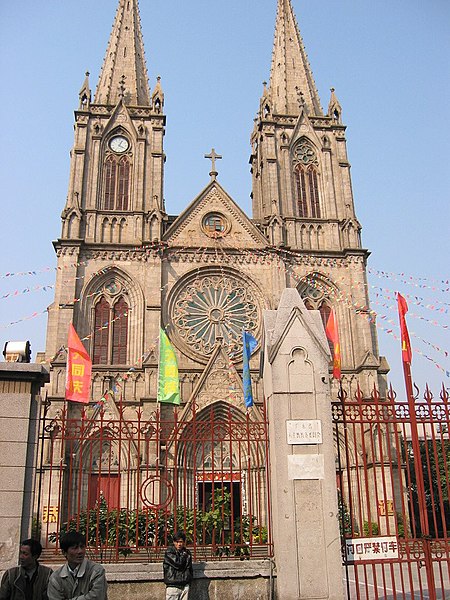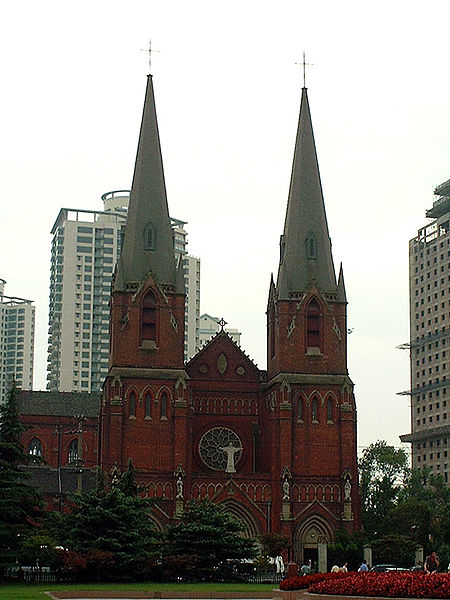Praxiteles
Forum Replies Created
- AuthorPosts
- March 25, 2006 at 11:27 pm in reply to: reorganisation and destruction of irish catholic churches #767992
Praxiteles
ParticipantThe Cathedral of Our Lady, Danang, Vietnam (1923)


 March 25, 2006 at 1:23 am in reply to: reorganisation and destruction of irish catholic churches #767991
March 25, 2006 at 1:23 am in reply to: reorganisation and destruction of irish catholic churches #767991Praxiteles
ParticipantSt. Michael’s Cathedral, Quindao, China



 March 25, 2006 at 1:07 am in reply to: reorganisation and destruction of irish catholic churches #767990
March 25, 2006 at 1:07 am in reply to: reorganisation and destruction of irish catholic churches #767990Praxiteles
ParticipantThe Church of the Sacred Heart in Fujian, China



 March 24, 2006 at 8:54 pm in reply to: reorganisation and destruction of irish catholic churches #767986
March 24, 2006 at 8:54 pm in reply to: reorganisation and destruction of irish catholic churches #767986Praxiteles
ParticipantThe Catholic Church in Kangding, China

 March 24, 2006 at 8:41 pm in reply to: reorganisation and destruction of irish catholic churches #767985
March 24, 2006 at 8:41 pm in reply to: reorganisation and destruction of irish catholic churches #767985Praxiteles
ParticipantThe Catholic Church in Dawu, China
 March 24, 2006 at 8:37 pm in reply to: reorganisation and destruction of irish catholic churches #767984
March 24, 2006 at 8:37 pm in reply to: reorganisation and destruction of irish catholic churches #767984Praxiteles
ParticipantThe Catholic Church in Pengzhou, Chengdu
 March 24, 2006 at 8:32 pm in reply to: reorganisation and destruction of irish catholic churches #767983
March 24, 2006 at 8:32 pm in reply to: reorganisation and destruction of irish catholic churches #767983Praxiteles
ParticipantThe Cathedral in Chongquing


The Catholic Church was built in Xianfeng Period, Qing Dynasty (1858).Situated on Mingsheng Road in Yuzhong District, it is the main church of Chongqing Parish. It covers an area of 18,298.6 square feet including a main hall of 5,382 square feet with a seating capacity of 1,000. Important rituals such as the Mass usually draws thousands of people.
March 24, 2006 at 7:43 pm in reply to: reorganisation and destruction of irish catholic churches #767982Praxiteles
ParticipantA more recent view of the Cathedral of Peking, China



“The largest church in China,” in brick and cast iron Gothic, with an elaborate grey marble facade, and built in 1890 by the French mission. The church was formerly the centre of a great complex of schools, orphanages and hospitals. The building has a tall, wide nave with side aisles, octagonal transepts and a huge sanctuary. There are many chandeliers, plus large, painted stations of the cross, old stained glass and the remains of old wall decoration. You could be in suburban Paris. The Patriotic Church re-occupied the building at the end of the Cultural Revolution (1966-76), and the church was restored in 1985. It now claims to house eight bishops and stands in spacious and beautiful grounds planted with big old pine and oak trees and with two Chinese pavilions. The magnificent facade of 1900 dates from after the Boxer Rebellion, when the cathedral compound, filled with converts fleeing the rebels, was besieged. Many people were killed here in the fighting before they were rescued by the Allied troops, led by British Indian soldiers.
March 24, 2006 at 7:43 pm in reply to: reorganisation and destruction of irish catholic churches #767981Praxiteles
ParticipantA more recent view of the Cathedral of Peking, China



“The largest church in China,” in brick and cast iron Gothic, with an elaborate grey marble facade, and built in 1890 by the French mission. The church was formerly the centre of a great complex of schools, orphanages and hospitals. The building has a tall, wide nave with side aisles, octagonal transepts and a huge sanctuary. There are many chandeliers, plus large, painted stations of the cross, old stained glass and the remains of old wall decoration. You could be in suburban Paris. The Patriotic Church re-occupied the building at the end of the Cultural Revolution (1966-76), and the church was restored in 1985. It now claims to house eight bishops and stands in spacious and beautiful grounds planted with big old pine and oak trees and with two Chinese pavilions. The magnificent facade of 1900 dates from after the Boxer Rebellion, when the cathedral compound, filled with converts fleeing the rebels, was besieged. Many people were killed here in the fighting before they were rescued by the Allied troops, led by British Indian soldiers.
March 24, 2006 at 7:09 pm in reply to: reorganisation and destruction of irish catholic churches #767980Praxiteles
ParticipantSt. Michael’s Cathedral in Quingdao, China (built 1934)
 March 24, 2006 at 3:04 am in reply to: reorganisation and destruction of irish catholic churches #767972
March 24, 2006 at 3:04 am in reply to: reorganisation and destruction of irish catholic churches #767972Praxiteles
ParticipantPatrick Charles Keely was born in Thurles, County Tipperary, Ireland, on August 9, 1816, the son of a builder who had moved to Thurles from Mlkenny to construct St. Patrick’s College. After its completion in 1837, the elder Keely acted as both architect and builder for the Fever Hospital, finished in 1840. What training in architectural design young Patrick received is unknown, but it is likely that he learned construction from his father.
At age 25 he sailed for America, settling in Brooklyn where he took up the carpentry trade. Among his first designs were altars at the Seminary at Lafargeville and in St. James’ Pro-cathedral in Brooklyn, for which he acted as superintendent of construction as well. In due course, a young priest of his acquaintance, Father Sylvester Malone, contacted Keely regarding a new church he planned to build in the Williamsburgh section of Brooklyn. Together they worked out a plan from which Keely developed a Gothic design. Its dedication in 1846 opened a new era in Catholic building, and Keely was besieged with requests for designs of churches and other buildings to serve the rapidly increasing immigrant population.
In 1849, a scant three years after completing his first church, Keely was called upon to design the Cathedral at Albany for Bishop McClusky, who was to become the first American cardinal. This was the first of 20 cathedrals for which he received commissions, including those in Chicago, Cleveland, Buffalo, Hartford, Newark, Providence, and, of course, Boston. His total output of churches is said to total more than 600, plus a number of institutional buildings, Virtually all of which were religiously oriented. The geographical distribution of Keely’s work ranged from Charleston, South Carolina to Halifax, Nova Scotia, and as far west as Iowa.
March 24, 2006 at 2:51 am in reply to: reorganisation and destruction of irish catholic churches #767971Praxiteles
ParticipantPatrick Charles KEELEY 1816-1896
P.C. Keeley’s importance as an architect can be gathered from the attached link which clearly shows that he was prime American architect and closely linked tot he Neo-Gothic revival movement’s major exponents such as A.W.N. Pugin and A.N. Didron.
March 24, 2006 at 2:42 am in reply to: reorganisation and destruction of irish catholic churches #767970Praxiteles
ParticipantSee posting no. 644
@Praxiteles wrote:
St Joseph’s, Albany, New York
Patrick Charles Keely
The interior, except ro the magnificent hammerbeam roof has been stripped and the church has just about escaped demolition.



 March 24, 2006 at 1:40 am in reply to: reorganisation and destruction of irish catholic churches #767967
March 24, 2006 at 1:40 am in reply to: reorganisation and destruction of irish catholic churches #767967Praxiteles
ParticipantAdolf Napoleon DIDRON, Annales Archéologiques, Vol. 13 (1853), p. 323. The annales were published in PAris between 1844 and 1871. They served as a forum for the excange of ideas about the neo gothic revival and other information on the same subject. The article mentioning Albany is entitled Renaissance de l’Architecture Chrétienne.
We know of Vasko. He is the greatest iconoclast on the face of the western world and responsible for the wreckage of much of North America’s cultural heritage.
What of ST. Joseph’s in Albany. It was built by the same architect, I think?
March 24, 2006 at 12:17 am in reply to: reorganisation and destruction of irish catholic churches #767962Praxiteles
ParticipantThe Cathedral in Jinan
German built
 March 24, 2006 at 12:02 am in reply to: reorganisation and destruction of irish catholic churches #767961
March 24, 2006 at 12:02 am in reply to: reorganisation and destruction of irish catholic churches #767961Praxiteles
ParticipantThe Cathedral in Mukden, China
 March 23, 2006 at 11:46 pm in reply to: reorganisation and destruction of irish catholic churches #767960
March 23, 2006 at 11:46 pm in reply to: reorganisation and destruction of irish catholic churches #767960Praxiteles
ParticipantThe Cathedral of the Immaculate Conception in Changsha, Hunan Province
(following an attack by the commies in 1930)
 March 23, 2006 at 11:30 pm in reply to: reorganisation and destruction of irish catholic churches #767959
March 23, 2006 at 11:30 pm in reply to: reorganisation and destruction of irish catholic churches #767959Praxiteles
ParticipantThe Catedral of Peking, China
 March 23, 2006 at 10:48 pm in reply to: reorganisation and destruction of irish catholic churches #767958
March 23, 2006 at 10:48 pm in reply to: reorganisation and destruction of irish catholic churches #767958Praxiteles
ParticipantSt. Ignatius’ Cathedral, Shanghai, China
Built in 1906
March 23, 2006 at 10:30 pm in reply to: reorganisation and destruction of irish catholic churches #767956Praxiteles
ParticipantThe Cathedral of the Sacred Heart in Canton City, China

The Catholic cathedral in Canton was built between 1860 to 1890. This neo-Gothic granite structure designed by a French architect is an amazing feat of workmanship by Chinese craftsmen with little knowledge of this type of construction. These workers had also to bear the brunt of the local population’s displeasure. Indeed, far from bringing Western missionaries and the people of Canton to some understanding and respect for each other, the building deepened the mistrust and became the focus of bitter disputes and clashes.
The uncompromising attitude and political maneuvering of Bishop Guillemin in the pursuit of his dream of a magnificent Gothic cathedral did nothing to alleviate Chinese suspicion of missionaries’ collusion with Western expansionist plans. He repeatedly disregarded local fengshu i and used French political and military might to his advantage in claiming a site for his new church. His pick was as much a political as a religious statement. Indeed, the location he set sight upon was the grounds of the governor-general palace destroyed in December 1857 by Anglo-French forces. In 1879, the bishop’s obsession with church constructions in his vicariate was to an extent responsible for his recall to Europe by Rome. Guillemin’s immediate successors were unable to defuse the population’s resentment against missionaries, the converts, and the cathedral.
On the Chinese side, the governor and governor-general vacillated between orders from Beijing to accommodate missionaries and demands from the local gentry for punitive actions against these same foreigners. This anti-foreign local elite played a crucial role in venting the population anger against the cathedral as the most obvious and prominent symbol of foreign impingement in the city. In 1880, an angry mob threatened the unfinished building and destroyed Christian housing. The onset of the conflict with France over Annam further increased the tension and led to a widespread persecution of Christians in the province. To prevent another riot in Canton, the governor-general ordered missionaries to leave and confiscated the property of the cathedral. The situation did not quiet down until the end of the Sino-French war in June 1885.
In today Canton, missionaries are gone, anti-foreignism is at an all-time low, and Catholicism is striving. The resentment against the cathedral, known by the population as the Stone House ( shishi ), has disappeared. In a strange twist of history, the present provincial government has declared the building a valued cultural monument. At long last, instead of being a divisive symbol in the city skyline, the Canton cathedral has become a peaceful testimony of a common heritage proudly treasured by East and West. - AuthorPosts

